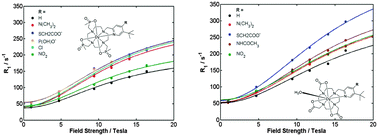Another challenge to paramagnetic relaxation theory: a study of paramagnetic proton NMR relaxation in closely related series of pyridine-derivatised dysprosium complexes†
Abstract
Measurements of the relaxation rate behaviour of two series of dysprosium complexes have been performed in solution, over the field range 1.0 to 16.5 Tesla. The field dependence has been modelled using Bloch–Redfield–Wangsness theory, allowing estimates of the electronic relaxation time, T1e, and the size of the magnetic susceptibility, μeff, to be made. Changes in relaxation rate of the order of 50% at higher fields were measured, following variation of the para-substituent in the single pyridine donor. The magnetic susceptibilities deviated unexpectedly from the free-ion values for certain derivatives in each series examined, in a manner that was independent of the electron-releasing/withdrawing ability of the pyridine substituent, suggesting that the polarisability of just one pyridine donor in octadenate ligands can play a significant role in defining the magnetic susceptibility anisotropy.


 Please wait while we load your content...
Please wait while we load your content...